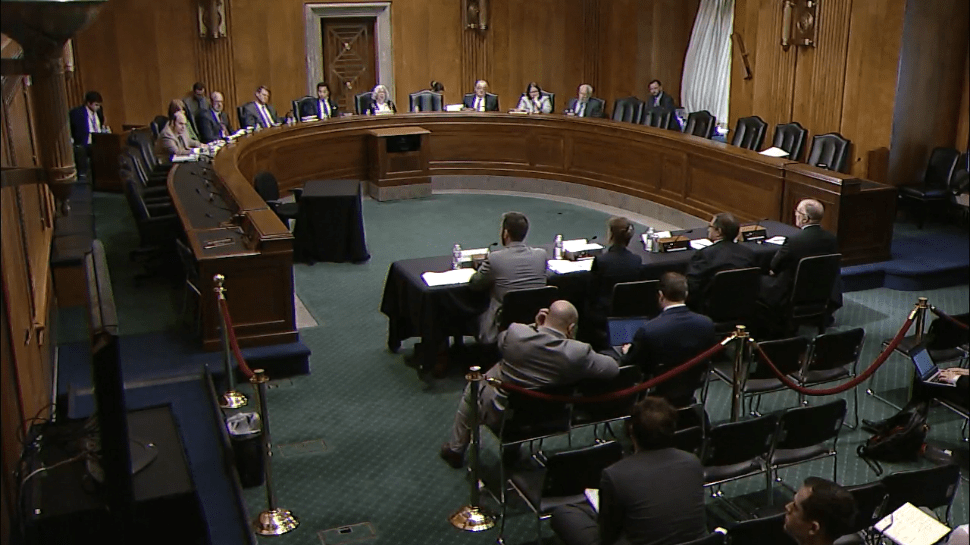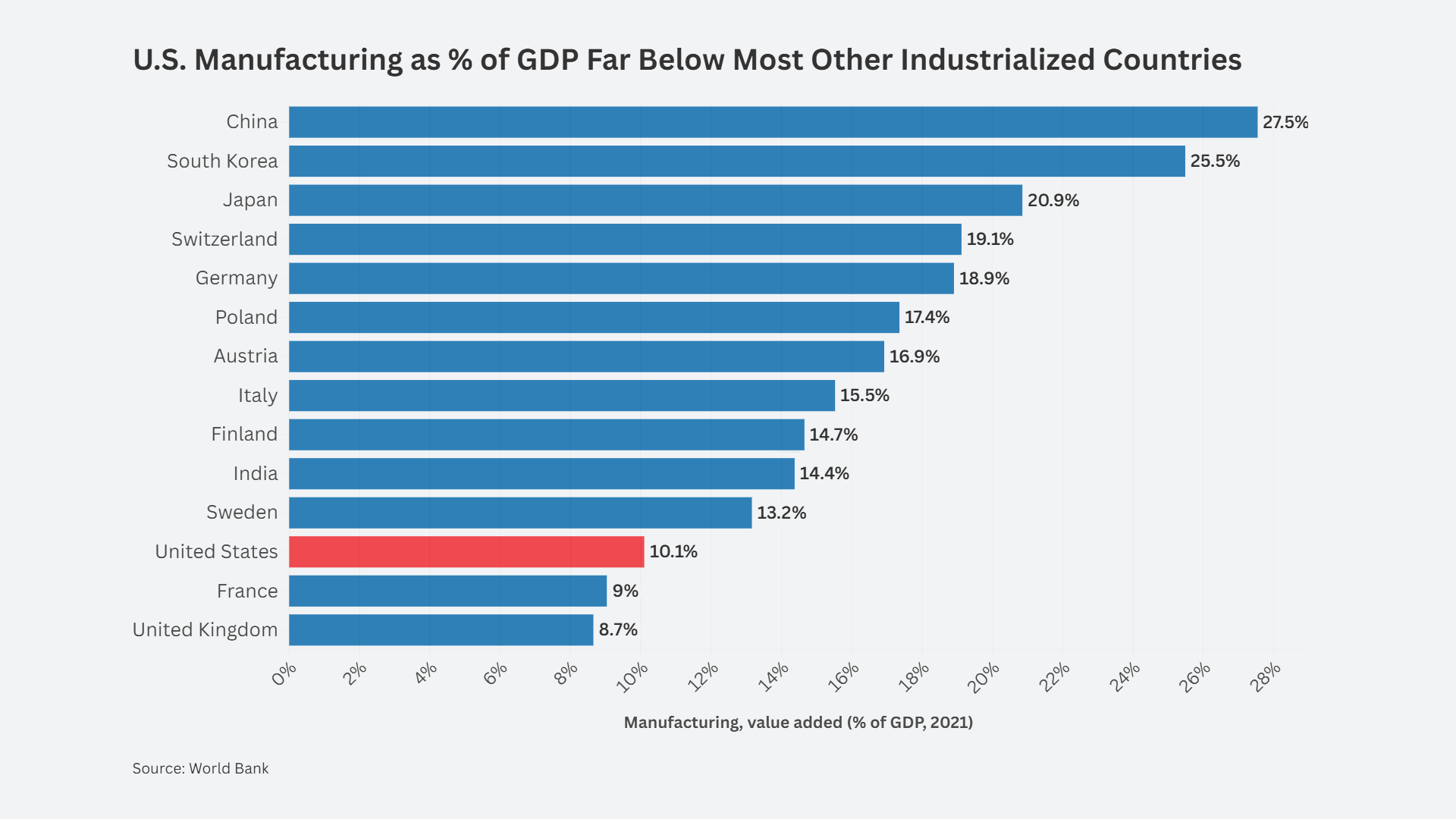Unless you work for the Pentagon or are in the Navy, you probably don’t know what an ASV is.
They are part of the so-called Uncrewed Marine Vehicles market (UMV) and in this case, an ASV is an autonomous seafaring vehicle – think of it as a drone on water. And China is a top player. Ocean Alpha is based in Hong Kong. Global UMV company iXblue, which also has a U.S. division in Rhode Island and is a defense contractor, also has offices in Beijing. It is unclear if they manufacture their underwater drones in China. But they probably do. CHC Navigation of Shanghai is one of the world’s biggest in this space, which can be used for everything from mapping the ocean floor to finding undersea wrecks to making mini-sea vehicles that are like the Big Brother of the seas – China can see you, but you can’t see them.
On Thursday, April 13, the U.S. China Economic and Security Review Commission heard from 10 witnesses to discuss China’s fast-growing rise to near-parity on American defense technology. The hearing, which focused on export restrictions of technologies that can be used to help China surpass the U.S. militarily, and in the high-speed tech sectors of quantum computing and artificial intelligence, had two main takeaways. First, China is not only gaining but surpassing, already. Second, export restrictions aren’t working because “working with allies” isn’t going according to plan.
“Their weapons development programs are amply resourced. They have other sources of funding, too, including tapping into capital markets,” said Tai Ming Cheung, Professor at the University of California, San Diego and Director of the UC Institute on Global Conflict and Cooperation [Testimony]. Cheung was talking about Shanghai, Shenzhen, and Hong Kong stock exchanges. U.S. investors are banned from buying the stocks in hundreds of Chinese defense contractors as of August 2021.
Cheung told the Commissioners that China has learned a lot from copying from the West – whether that is building a new Boeing competitor in the 12-year-old Commercial Aircraft Corporation of China (which sold its first plane to an Indonesian airline in 2021) – or advanced microchips. They are now doing original home-based innovation because China is keenly aware that it will be cut off from advanced U.S. technologies. “This home-grown focus will be important going forward with long-term plans in place,” Cheung said. “There is a shift from absorption of Western technologies to original development and innovation.”
 Christian Curriden, Defense Analyst at the RAND Corporation [Testimony], said China has the patience, the ambition, and with new geopolitical stresses that began in 2017 and are still in place, an impetus to throw a lot of money at new technologies.
Christian Curriden, Defense Analyst at the RAND Corporation [Testimony], said China has the patience, the ambition, and with new geopolitical stresses that began in 2017 and are still in place, an impetus to throw a lot of money at new technologies.
“Given time, they are very capable of producing weapons that would be a dire threat to the U.S. or throughout the Asian Pacific,” Curriden said. “As inefficient as the system seems to be, China is very focused and has been successful and has thrown a lot of money at this problem. They are smaller than the U.S. in terms of their defense industrial base, but they are getting comparable.”
Commissioner Bob Borochoff was worried, echoing the concerns of every other commissioner. The sense of every U.S. China Economic and Security Review Commission hearing is that the U.S. is one step behind. And, worse, American companies have made it so. Perhaps worse yet, most American allies are not on the same page when it comes to China. For instance, with the export restrictions on microchip manufacturing equipment, only Japan and The Netherlands are on board. But Germany, which makes optical lenses and lasers that Dutch semiconductor equipment manufacturer ASML needs, is not restricting anything, meaning China can import those things and reverse engineer the equipment they have now, including ASML units. They’ll eventually make the equipment themselves. Everyone knows this. Fending them off is a total head-scratcher for the Commission and the witnesses.
At one moment in the hearing, Borochoff recalled when he would attend manufacturing expos for defense contractors back in the 1980s. “The Chinese would come to those expos and take pictures of equipment and we all thought it was funny,” he said. “But today a lot of those companies don’t exist anymore and the equipment they once made is all made in China.”
Elsa Kania , Adjunct Senior Fellow, Technology and National Security Program at the Center for a New American Security, said China’s institutional scale (think research institutions and government) is unmatchable. “They have the scale and capacity beyond what we have at this point. We might be more creative and experimental, but ultimately the question is who can run with what they design and who can fully leverage their technological capabilities,” she said. “China has invested heavily in drones. They lead the commercial and hobby drone market worldwide. But the same company that makes retail drones, DJI, makes drones for combat,” she said about the company on the Commerce Department’s Entity List. China drones were also being retrofitted in Ukraine to deliver payloads on the battlefield in its war against Russia. “China’s capacity for (manufacturing) is immense. If you look at shipbuilding…their capacity to build ships is quite significant.”
, Adjunct Senior Fellow, Technology and National Security Program at the Center for a New American Security, said China’s institutional scale (think research institutions and government) is unmatchable. “They have the scale and capacity beyond what we have at this point. We might be more creative and experimental, but ultimately the question is who can run with what they design and who can fully leverage their technological capabilities,” she said. “China has invested heavily in drones. They lead the commercial and hobby drone market worldwide. But the same company that makes retail drones, DJI, makes drones for combat,” she said about the company on the Commerce Department’s Entity List. China drones were also being retrofitted in Ukraine to deliver payloads on the battlefield in its war against Russia. “China’s capacity for (manufacturing) is immense. If you look at shipbuilding…their capacity to build ships is quite significant.”
Although the Commission did not touch upon this, one of the overarching themes in Thursday’s six hour session was that China can make things fast, and has the labor force and the manufacturing might to get it done. Manufacturing advocates here in the U.S. have argued for years that our eroded industrial base would eventually mean that the U.S. could not compete with China on mass production. We are now officially there, judging by what every panelist suggested at this hearing.
Commissioner Michael Wessel said economic and national security are “increasingly fused” and that China has long ago considered economic security national security.
“China used to be focused on more asymmetrical defense (think cyber warfare), but now they can do that plus build a bomber at the same time,” said Curriden. “They have the capital to do it. Ten years ago they did not. We should restrict some stealth defense technologies from going to China, but restricting the dual use is a harder question,” he said about technologies that can be used for consumers as easily as they can be used for defense tools, like the DJI drones on sale on Amazon.com.
 Commissioner Randall Schriver said he was not very optimistic about the private sector joining in some government workshops to teach them of the risks, an idea proposed by one of the witnesses. “Do we know enough about the chokepoints that may exist, and what we can potentially control to thwart China?” he asked Sarah Kirchberger, Head of Asia-Pacific Strategy and Security at the Institute for Security Policy, Kiel University [Testimony]. It was Kirchberger who proposed a more coordinated workshop approach to get companies up to speed on who they’re in business with in China.
Commissioner Randall Schriver said he was not very optimistic about the private sector joining in some government workshops to teach them of the risks, an idea proposed by one of the witnesses. “Do we know enough about the chokepoints that may exist, and what we can potentially control to thwart China?” he asked Sarah Kirchberger, Head of Asia-Pacific Strategy and Security at the Institute for Security Policy, Kiel University [Testimony]. It was Kirchberger who proposed a more coordinated workshop approach to get companies up to speed on who they’re in business with in China.
She didn’t have good news for Schriver. “In some sectors, that ship has sailed,” she said in a slight German accent. In thinking of ASV’s, she said that there was an array of countries cooperating with undersea military technologies. And that for an American firm, it may not be easy to know who the ownership is of a company. They have English language names. They’re based in the Caribbean or the “friendly city” of Hong Kong.
“You can go after these companies and they change names. You might not know that they are part of a Chinese state-owned company. You can’t look up their website because they’ve scrubbed it and you’d have to use the Way Back Machine. You can’t look into their technology and what it is used for because we don’t have access to their scientific journals database anymore,” Kirchberger said. This happened during the Covid fiasco. China shut down access to its scientific journals database because people were inquiring about SARS research at the Wuhan Institute of Virology.
 Gregory Allen, Director, Wadhwani Center for AI and Advanced Technologies, Center for Strategic and International Studies [Testimony] said that the Commerce does not have the resources to police its own Entity List. Are export restrictions even working? Allen is not convinced that they are. The Bureau of Industry and Security, which is in charge of the Entity List, lacks the tools and human capital to see what to ban and ensure that restrictions are working.
Gregory Allen, Director, Wadhwani Center for AI and Advanced Technologies, Center for Strategic and International Studies [Testimony] said that the Commerce does not have the resources to police its own Entity List. Are export restrictions even working? Allen is not convinced that they are. The Bureau of Industry and Security, which is in charge of the Entity List, lacks the tools and human capital to see what to ban and ensure that restrictions are working.
What about the venture capital community of Silicon Valley? They love Chinese tech.
“At this point, it is inappropriate for any U.S. venture capital firm or investor to be making investments in Chinese artificial intelligence,” Allen told the Commissioners, who by now have had an earful of bad news on China’s tech threat. “The CHIPS Act is good and tells companies that if they get money to make chips here they cannot make investments in the same product lines in China. But that is just semiconductors. There is so much more we can do,” he said, adding that top of mind for him was to increase the bureaucracy in Commerce, people who would be singularly tasked with export controls.
“We need to think about how to keep ahead because China is not going to stop,” said Kevin Pollpeter, Senior Research Scientist at the Center for Naval Analysis [Testimony].
It’s not just the defense side of manufactured goods. China’s civilian-military fusion makes it hard for the U.S. to ban products. The same electronics that go into fifth generation fighter planes might also go into COMAC’s new ARJ-21. Boeing helped China get up to speed on building wide-body aircraft that can compete with them, and their French counterpart Airbus.
“China has made significant progress in all aviation areas, both commercial and defense, though the U.S. is still the leader here,” said Chad Ohlandt, Senior Engineer for the RAND Corporation [Testimony]. “They’ve invested billions in commercial aircraft. They don’t yet have a globally competitive product, but they are distorting the market already, especially locally, and they will continue to break into and eventually take market share away from Boeing worldwide.”
CPA vice president for national security, Robby Smith Saunders, said after the hearing that there is much room for improvement on export restrictions.
“It is a good effort but there needs to be updating,” she said. “I think taking an interagency approach is needed and that there should be greater coordination between companies on the Entity List and companies on the Treasury sanctions list. We have a very incoherent process now and that has led to way too many exceptions and export licenses given to companies,” she said.
She also said that companies facing export restrictions, or those on the Entity List, should be banned from receiving investment capital from the U.S. “There needs to be greater interagency coordination on this,” she said.













